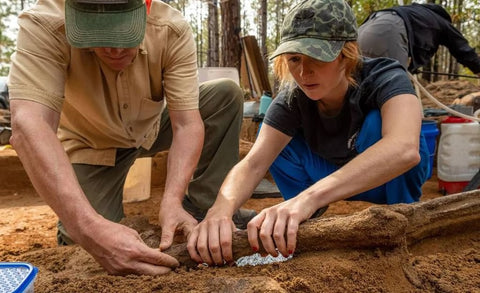
Revolutionary War Soldiers Slated for Reburial 243 Years After Battle
The rediscovered remains of American Revolutionary War soldiers who died in South Carolina more than 240 years ago are set to be reinterred this weekend in a ceremony to honor their sacrifice to a budding nation.
Archeologists excavated the skeletal remains of 14 individuals in fall 2022 at the Camden Battlefield, the site of a 1780 British victory during America’s fight for independence.
“Honoring these heroes in a respectful manner and ensuring the permanent protection of their remains continues to be the mission of this effort,” Doug Bostick, CEO of the South Carolina Battleground Preservation Trust, said in a release.
The reburial of the unknown soldiers will honor some of America’s earliest fallen and advance current understanding of how the important battle unfolded.
Recovering remains of history
Some of the soldiers’ remains were first discovered during the past few years by looters searching for artifacts, Bostick said in an interview with Military Times.
A team of archeologists and anthropologists launched an ensuing excavation in September 2022 and uncovered even more remains. Some remains discovered during the eight-week search were found in shallow graves less than six inches below ground.
An initial examination of the soldiers concluded 12 of the bodies are likely Patriot Continental soldiers from either Maryland or Delaware, one is likely a North Carolina loyalist and another served with the British 71st Regiment of Foot, Fraser’s Highlanders, the nonprofit said in a release.
Forensic anthropologists are continuing to craft biological profiles for each of the troops.
At least five of the Continentals were determined to have been teenagers, while the oldest soldier is estimated to have died when he was between 40 and 50 years old. Some possess clear evidence of battle injuries from musket balls and buck shot.
The Scottish Highlander is the only soldier who appears to have been carefully laid to rest, face up with his arms crossed. Others were found face down or overlaying each other. Based on the historical record, the Highlander’s identity has already been narrowed to three potential candidates, Bostick said, but it will only be confirmed when a DNA analysis is complete.
Researchers are collecting DNA so that individuals with a suspected connection to the soldiers can provide a sample to help the identification process, though that undertaking can take some time, Bostick said.
The loyalist militiaman is thought to have Native American ancestry and is not a part of this weekend’s events. Instead, he is scheduled to be honored in a private ceremony with local tribes.
The August 16, 1780, Battle of Camden was a devastating defeat for the Americans in the early stages of the British military offensive in the south. It did, however, usher in changes in the rebellious colonists’ military leadership that eventually altered the war’s course.
The recent recovery of remains in South Carolina comes on the heels of a similar discovery during summer 2022, when scientists uncovered a mass grave in New Jersey with as many as a dozen German soldiers, called Hessians, who fought alongside the British.
Honoring early heroes
The full slate of weekend festivities — a funeral procession at Fort Jackson, historic reenactments, a military flyover and more — is expected to draw lawmakers, foreign troops and public spectators.
Historians are looking to keep the burial as authentic to the time period as possible. The soldiers’ coffins are handcrafted in an 18th-century design using hand-forged nails and wood from longleaf pine trees thought to have grown not far from where the historic battle took place.
At the conclusion of the funeral service and military honors, the soldiers will be reinterred in the seven locations where they were found on the battlefield.
“The work we are doing honors their sacrifice by shedding light on details that are not yet documented in the historical record,” archeologist James Legg said in the release. Legg added that the marked graves will now allow “for the contemplation of battlefield visitors.”
Originally published on Military Times, our sister publication.
